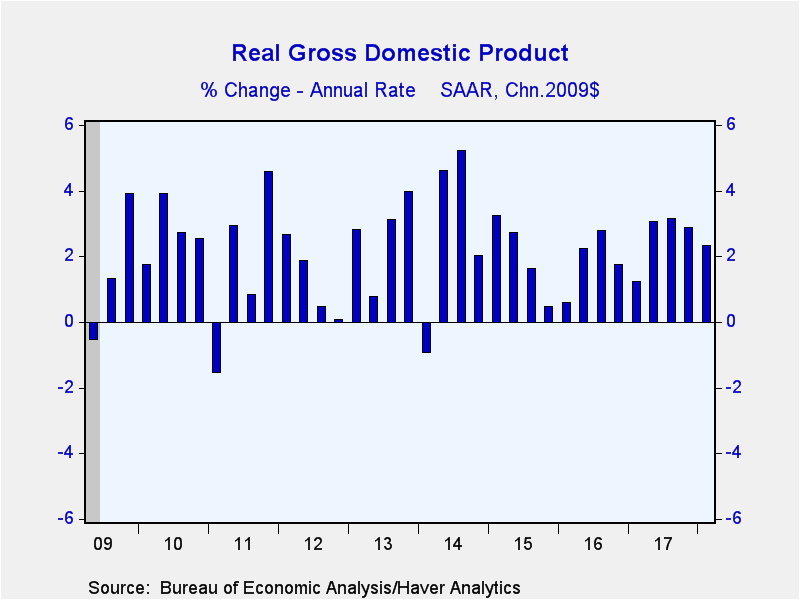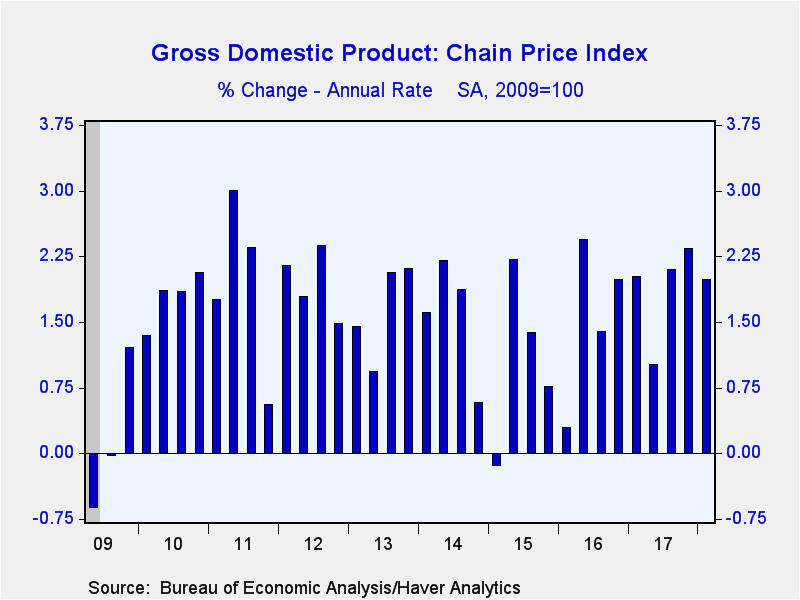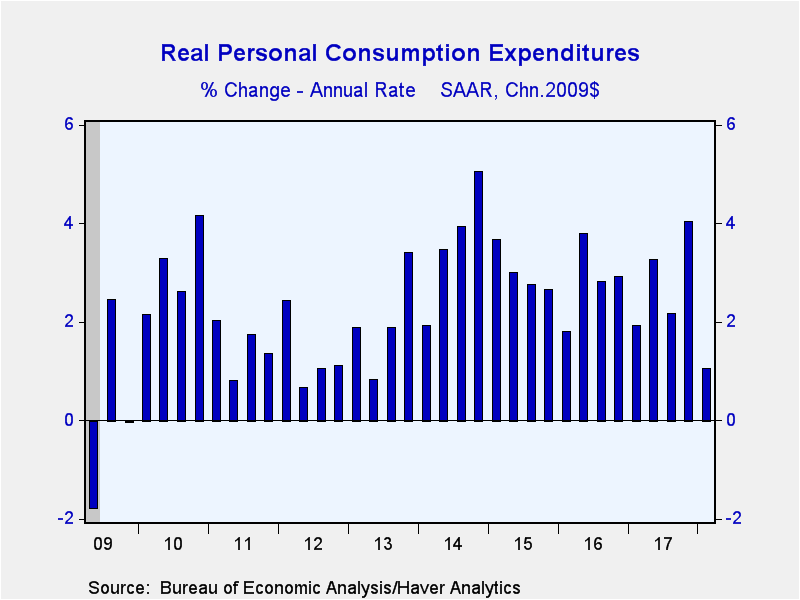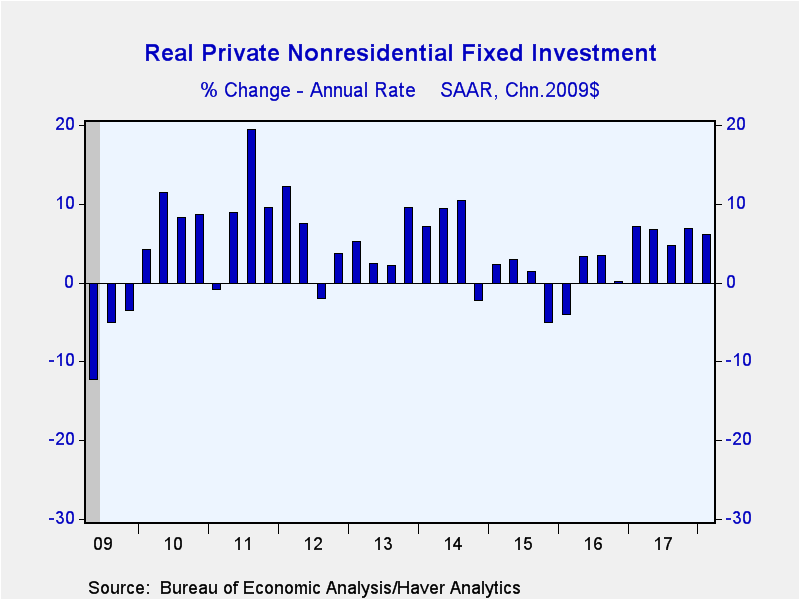 Global| Apr 27 2018
Global| Apr 27 2018U.S. GDP Growth Moderates; Domestic Demand Weakens
by:Tom Moeller
|in:Economy in Brief
Summary
U.S. economic growth continued to slow in Q1'18. In the advance estimate, gross domestic product grew at a 2.3% annual rate following Q4'17 growth of 2.9% and a 3.2% gain during Q3'17. A 2.1% increase had been expected in the Action [...]
U.S. economic growth continued to slow in Q1'18. In the advance estimate, gross domestic product grew at a 2.3% annual rate following Q4'17 growth of 2.9% and a 3.2% gain during Q3'17. A 2.1% increase had been expected in the Action Economics Forecast Survey. Slower growth in domestic final demand to 1.6% (2.7% y/y) from 4.5% accounted for the moderation last quarter. Growth in the GDP price index remained firm at 2.0% (1.9% y/y).
Growth in GDP last quarter was the weakest since Q1'17. It reflected 1.1% growth in consumer spending which was the slowest since the second quarter of 2013. It also was a payback for a 4.0% surge in Q4. Spending restraint was notable in the durable goods sector where purchases declined 3.3% (+6.5% y/y) after a 13.7% Q4 surge. Motor vehicle & parts buying pulled back 15.0% (+3.4% y/y) on the heels of two straight quarters of double-digit growth. Growth in home furnishings buying of 0.6% (7.8% y/y) followed a 13.1% Q4 surge. Recreation goods & vehicle purchases grew 6.8% (8.3% y/y) after a 12.8% rise. In the nondurable goods sector, spending came to a standstill. The 0.1% uptick (2.8% y/y) followed 4.8% growth in Q4. The pullback was led by a 9.1% decline (+2.5% y/y) in apparel outlays following a 10.6% spurt at yearend. Gasoline & fuel oil spending also fell 3.3% (0.6% y/y) after a 0.1% increase. Food & beverage outlays grew 0.4% following a 6.8% rise. Service sector spending growth remained firm and fairly steady at 2.1% (1.9% y/y). Transportation outlays grew 3.4% (1.6% y/y) after a 4.7% improvement. Health care purchases increased a steady 2.9% (2.8% y/y) and spending on recreation advanced 1.5% (0.6% y/y) following a 0.9% decline. Housing utilities improved just 0.2% (1.4% y/y) following a 2.1% gain.
Also contributing to the slowdown in final demand growth was the residential building sector where activity was little changed (-0.1% y/y) after a 12.8% rise in Q4.
Government sector spending grew at a 1.2% rate both q/q and y/y after a 3.0% rise. Federal government spending improved 1.7% (2.0% y/y) following a 3.2% rise. Slower growth in defense spending of 1.8% (3.6% y/y) after a 5.5%. This rise was accompanied by a pickup in nondefense outlay growth to 1.6% (-0.2% y/y) from -0.1%. State & local government purchases grew 0.8% (0.6% y/y) following a 2.9% increase.
Business fixed investment growth was fairly steady, rising at a 6.1% rate both q/q and y/y. These growth rates were up, however, from 4.7% during all of last year and -0.6% in 2016. Structures investment jumped 12.3% (4.4% y/y), the strongest growth rate in a year. Equipment spending increased 4.7% (8.9% y/y) following two quarters of double-digit growth. Information processing equipment spending advanced 9.7% (9.9% y/y) following an 8.4% rise, but investment in transportation equipment growth slowed to 4.6% (8.9% y/y) following two quarters of roughly 15.0% gains. Investment in industrial equipment grew a steady 4.2% (7.0% y/y). Accelerating was growth in intellectual property products to 3.6% (3.3% y/y) from 0.9%. These advances compared to 3.9% during all of last year and 6.3% in 2016.
Offsetting some of the slowdown in final demand was a 0.4% percentage point addition to GDP growth from business inventories after a 0.5 percentage point subtraction in Q4. Improvement in foreign trade also contributed 0.2 percentage points following a 1.2 percentage subtraction. Exports grew 4.8% (4.3% y/y) following a 7.0% rise, but import growth of 2.6% (4.2% y/y) slowed to a greater degree from 14.1%.
Slightly slower price inflation was registered as the GDP price index increased 2.0% (1.9% y/y) following a 2.3% gain. Nevertheless, these growth rates were the quickest in six years. The PCE price index increased 2.7% (1.8% y/y), the same as in Q4 and greatly elevated from early last year. These were the quickest growth rates in the price index since 2011. The acceleration was sparked by faster consumer services price growth which offset declining prices for consumer durable goods. Business fixed investment price growth also accelerated to 1.2% y/y, double the growth in 2015. Residential fixed investment prices grew 5.0% y/y, up from 2.7% in 2015.
The GDP figures can be found in Haver's USECON and USNA database. USNA contains virtually all of the Bureau of Economic Analysis' detail in the national accounts, including the integrated economic accounts and the recently added GDP data for U.S. Territories. The Action Economics consensus estimates can be found in AS1REPNA.
Less Food & Energy
Tom Moeller
AuthorMore in Author Profile »Prior to joining Haver Analytics in 2000, Mr. Moeller worked as the Economist at Chancellor Capital Management from 1985 to 1999. There, he developed comprehensive economic forecasts and interpreted economic data for equity and fixed income portfolio managers. Also at Chancellor, Mr. Moeller worked as an equity analyst and was responsible for researching and rating companies in the economically sensitive automobile and housing industries for investment in Chancellor’s equity portfolio. Prior to joining Chancellor, Mr. Moeller was an Economist at Citibank from 1979 to 1984. He also analyzed pricing behavior in the metals industry for the Council on Wage and Price Stability in Washington, D.C. In 1999, Mr. Moeller received the award for most accurate forecast from the Forecasters' Club of New York. From 1990 to 1992 he was President of the New York Association for Business Economists. Mr. Moeller earned an M.B.A. in Finance from Fordham University, where he graduated in 1987. He holds a Bachelor of Arts in Economics from George Washington University.












